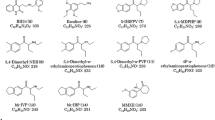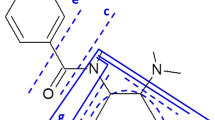Abstract
Purpose
Since the early 2010s, synthetic opioids have been on the rise in the illicit drug markets of North America and Europe, often as adulterants or substitutes for heroin. Ocfentanil, an early-onset fentanyl analogue, has been implicated in several fatalities, predominantly in Europe. W-18 is more prevalent in Canada and the United States. We present the findings for an unknown brown powder, advertised and purchased as heroin, which was sent to our laboratory for analysis in the framework of the Belgian Early Warning System on Drugs.
Methods
The sample was screened using liquid chromatograph coupled to a diode array detector and gas chromatograph coupled to a single quadrupole mass spectrometer. The findings were confirmed by liquid chromatography—triple quadrupole mass spectrometry.
Results
No heroin, 6-monoacetylmorphine or morphine was detected. Our analysis detected two new psychoactive substances: the synthetic opioid ocfentanil (1.6% m/m), and W-18 (0.3% m/m). The ocfentanil concentration was similar to those found in previous reports. No reference concentrations have been published for W-18. The presence of these two new psychoactive substances together in the same powder is unprecedented and prompted a warning by the Belgian Early Warning System on Drugs.
Conclusion
The unknown powder tested positive for ocfentanil and W-18. To the authors’ best knowledge this is the first case of the combined detection of these two new psychoactive substances in the same powder. We additionally demonstrate the advantage of building an in-house reference library beyond retention time.



Similar content being viewed by others
Abbreviations
- CSL:
-
Cayman Spectral Library
- dMRM:
-
Dynamic multiple reaction monitoring
- DAD:
-
Diode array detector
- GC:
-
Gas chromatography
- LC:
-
Liquid chromatography
- MS:
-
Mass spectrometry
- QQQ:
-
Triple quadrupole mass spectrometer
- RT:
-
Retention time
References
European Monitoring Centre for Drugs and Drug Addiction (2018) Fentanils and synthetic cannabinoids: driving greater complexity into the drug situation—an update from the EU Early Warning System. Publications Office of the European Union, Luxembourg
Rudd RA, Seth P, David F, Scholl L (2016) Increases in drug and opioid-involved overdose deaths—United States, 2010–2015. US Department of Health and Human Services / Centers for Disease Control and Prevention, Atlanta
United Nations Office on Drugs and Crime (2017) Fentanyl and its analogues—50 years on. Global Smart Update, Vienna
European Monitoring Centre for Drugs and Drug Addiction (2018) European drug report 2018: trends and developments. Publications Office of the European Union, Luxembourg
Allibe N, Richeval C, Phanithavong M et al (2018) Fatality involving ocfentanil documented by identification of metabolites. Drug Test Anal 10:995–1000. https://doi.org/10.1002/dta.2326
Zawilska JB (2017) An expanding world of novel psychoactive substances: opioids. Front Psychiatry 8:110. https://doi.org/10.3389/fpsyt.2017.00110
Coopman V, Cordonnier J, De Leeuw M, Cirimele V (2016) Ocfentanil overdose fatality in the recreational drug scene. Forensic Sci Int 266:469–473. https://doi.org/10.1016/J.FORSCIINT.2016.07.005
Fletcher JE, Sebel PS, Murphy MR et al (1991) Comparison of ocfentanil and fentanyl as supplements to general anesthesia. Anesth Analg 73:622–626
Misailidi N, Papoutsis I, Nikolaou P et al (2018) Fentanyls continue to replace heroin in the drug arena: the cases of ocfentanil and carfentanil. Forensic Toxicol 36:12–32. https://doi.org/10.1007/s11419-017-0379-4
Drug Enforcement Administration (2018) Schedules of controlled substances: temporary placement of seven fentanyl-related substances in schedule I. temporary amendment; temporary scheduling order. Fed Regist 83:4580–4585
Canadian Centre on Substance Abuse (2016) Novel synthetic opioids in counterfeit pharmaceuticals and other illicit street drugs. Canadian Community Epidemiology Network on Drug Use, Ottawa
Prekupec MP, Mansky PA, Baumann MH (2017) Misuse of novel synthetic opioids: a deadly new trend. J Addict Med 11:256–265. https://doi.org/10.1097/ADM.0000000000000324
Huang X-P, Che T, Mangano TJ et al (2017) Fentanyl-related designer drugs W-18 and W-15 lack appreciable opioid activity in vitro and in vivo. JCI Insight 2:e97222. https://doi.org/10.1172/jci.insight.97222
Cannaert A, Stove C (2018) Personal mail communication: W-18 receptor binding activity
Cannaert A, Vasudevan L, Friscia M et al (2018) Activity-based concept to screen biological matrices for opiates and (synthetic) opioids. Clin Chem 64:1221–1229. https://doi.org/10.1373/clinchem.2018.289496
Cayman Chemical (2012) Cayman Spectral Library. In: Online database. https://www.caymanchem.com/forensic/csl/?q=*%3A*. Accessed 17 Jul 2018
Dussy FE, Hangartner S, Hamberg C et al (2016) An acute ocfentanil fatality: a case report with postmortem concentrations. J Anal Toxicol 40:761–766. https://doi.org/10.1093/jat/bkw096
Marchard A, Martin-Molins C, Moal A et al (2017) L’ocfentanil: un bon exemple des dangers des NPS (new psychoactive substances). Toxicol Anal Clin 29:S63. https://doi.org/10.1016/J.TOXAC.2017.03.091
Graddy R, Buresh ME, Rastegar DA (2018) New and emerging illicit psychoactive substances. Med Clin North Am 102:697–714. https://doi.org/10.1016/J.MCNA.2018.02.010
Stanley TH (2014) The fentanyl story. J Pain 15:1215–1226. https://doi.org/10.1016/J.JPAIN.2014.08.010
Acknowledgements
The authors would like to thank Tessa Windelinckx (Free Clinic vzw, Schijnpoortweg 14, 2060 Antwerp, Belgium) for providing the sample.
Author information
Authors and Affiliations
Corresponding authors
Ethics declarations
Conflict of interest
Alexander van Nuijs received a postdoctoral scholarship from the Research Foundation Flanders (FWO, Grant no. 1285216N).
Ethical standards
This article does not contain any studies involving living human participants or animals, performed by any of the authors.
Additional information
Publisher's Note
Springer Nature remains neutral with regard to jurisdictional claims in published maps and institutional affiliations.
Electronic supplementary material
Below is the link to the electronic supplementary material.
Rights and permissions
About this article
Cite this article
Degreef, M., Blanckaert, P., Berry, E.M. et al. Determination of ocfentanil and W-18 in a suspicious heroin-like powder in Belgium. Forensic Toxicol 37, 474–479 (2019). https://doi.org/10.1007/s11419-019-00480-3
Received:
Accepted:
Published:
Issue Date:
DOI: https://doi.org/10.1007/s11419-019-00480-3




